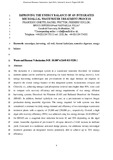JavaScript is disabled for your browser. Some features of this site may not work without it.
| dc.contributor.author | Ometto, Francesco | - |
| dc.contributor.author | Whitton, Rachel | - |
| dc.contributor.author | Coulon, Frederic | - |
| dc.contributor.author | Jefferson, Bruce | - |
| dc.contributor.author | Villa, Raffaella | - |
| dc.date.accessioned | 2014-09-04T04:01:14Z | |
| dc.date.available | 2014-09-04T04:01:14Z | |
| dc.date.issued | 2014-04-01T00:00:00Z | - |
| dc.identifier.citation | Francesco Ometto, Rachel Whitton, Frédéric Coulon, Bruce Jefferson, Raffaella Villa, Improving the energy balance of an integrated microalgal wastewater treatment process, Waste and Biomass Valorization, April 2014, Volume 5, Issue 2, Pages 245-253. | |
| dc.identifier.issn | 1877-2641 | - |
| dc.identifier.uri | http://dx.doi.org/10.1007/s12649-013-9230-2 | - |
| dc.identifier.uri | http://dspace.lib.cranfield.ac.uk/handle/1826/8675 | |
| dc.description.abstract | The inclusion of a microalgal system in a wastewater treatment flowsheet for residual nutrient uptake can be justified by processing the waste biomass for energy recovery. Low energy harvesting technologies and pre-treatment of the algal biomass are required to improve the overall energy balance of this integrated system. Scenedesmus obliquus and Chlorella sp., achieving nitrogen and phosphorus removal rates higher than 90 %, were used to compare cells recovery efficiency and energy requirements of two energy efficient harvesting systems: dissolved air flotation (DAF) and ballasted dissolved air flotation (BDAF). In addition, thermal hydrolysis was used as a pre-treatment to improve biogas production during anaerobic digestion. The energy required for both systems was then considered to estimate the daily energy demand and efficiency of two microalgae wastewater treatment plants with a capacity of 25,000 and 230,000 p.e., respectively. Overall, a high algal cells recovery efficiency (99 %) was achieved using low energy demand (0.04 kWh m-3 for BDAF) and a coagulant dose reduction between 42 and 50 % depending on the algal strain. Anaerobic digestion of pre-treated S. obliquus showed a threefold increase in methane yield. Compared to a traditional activated sludge process, the additional tertiary microalgal treatment generates an integrated process potentially able to achieve up to 76 % energy efficiency. | en_UK |
| dc.rights | The original publication is available at www.springerlink.com | |
| dc.title | Improving the energy balance of an integrated microalgal wastewater treatment process | en_UK |
| dc.type | Article | - |
Files in this item
This item appears in the following Collection(s)
-
Staff publications (SAS) [907]
